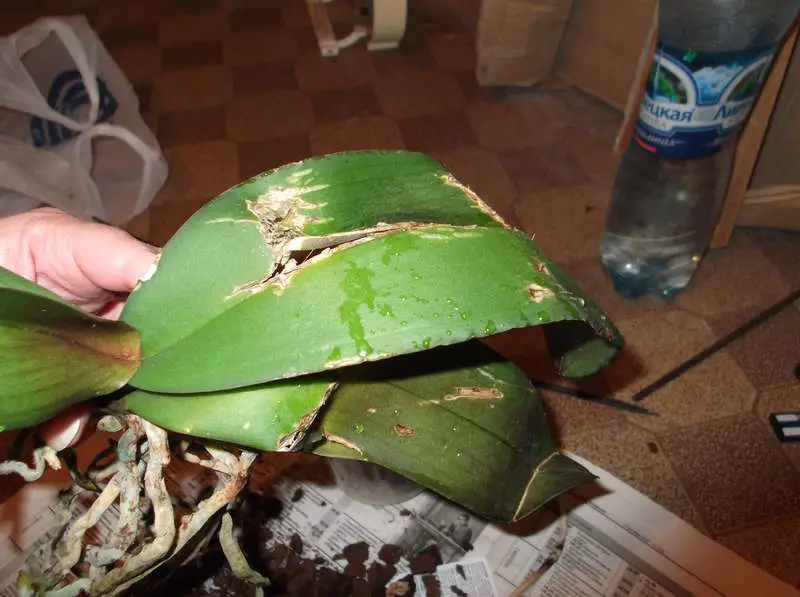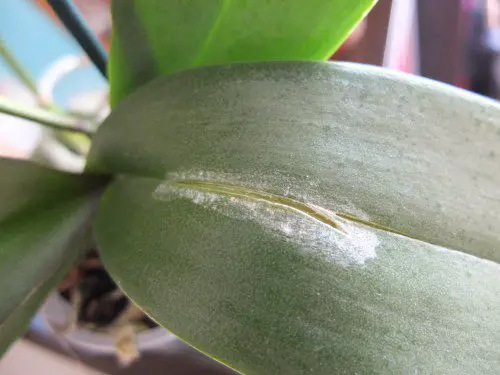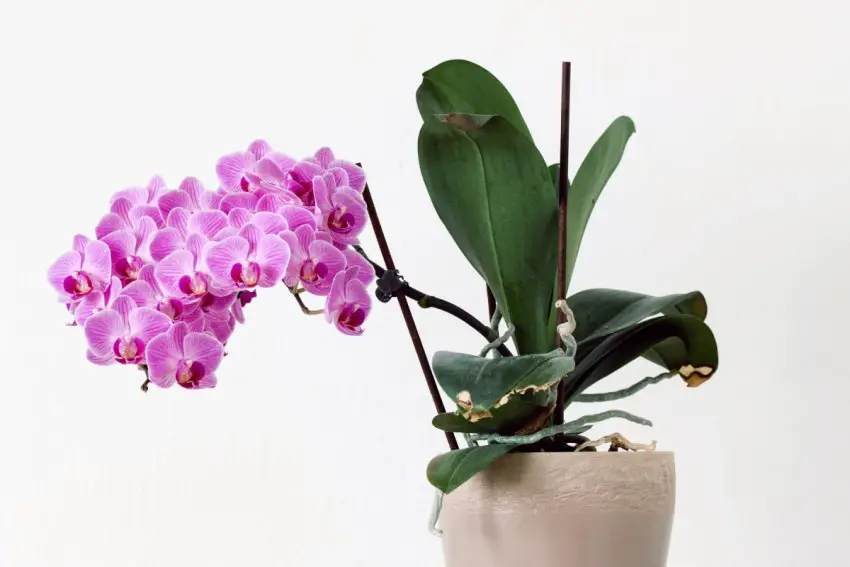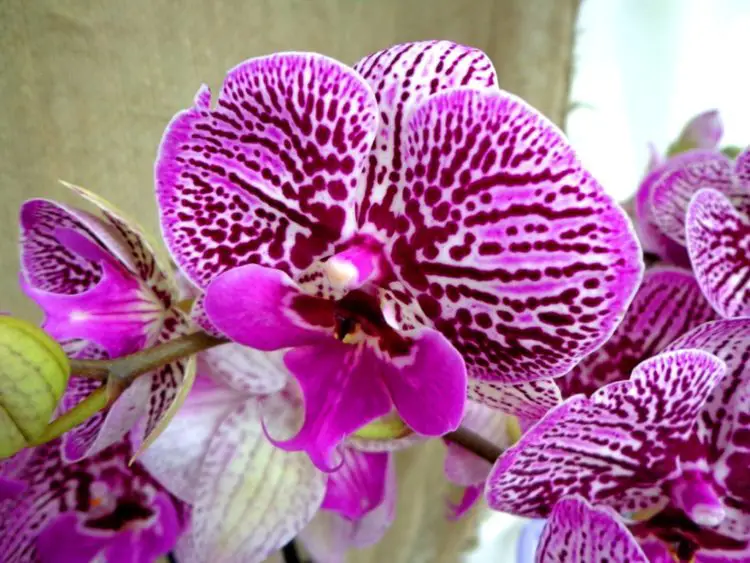
Often beginners ask experienced plant growers why orchid leaves are cracking. Prevention against diseases and knowledge of ways to restore the sprout will prevent its death.
Indoor flowers delight gardeners not only with the beauty of the inflorescences but also with the greenery of lush foliage. These flowers have become popular in greenhouses and are grown on windowsills in homes. The most careful care is necessary for orchids since any mistake can lead to the deformation of the leaf plates. Consider what to do if the leaves of the phalaenopsis have already begun to crack.
When the leaves of orchids are broken and cracking
Visual inspection of the flower will show a break in the middle of the leaf plates. Basically, in an orchid, leaves in the lower tier crack like this. At the same time, they do not disappear, but continue to develop and grow in an unsightly form. The entire sprout is under stress from disturbances in the metabolism of nutrients, since the middle of the leaf is divided.
This condition is provided by the reasons:
- excessive or insufficient watering;
- surplus fertilizers;
- location;
- environment in terms of air temperature and humidity;
- mechanical damage;
- lack of roots or their diseases.
In any case, you need to find out the reason for the bifurcation of the leaf in order to restore a healthy look to the orchid. Growing medium has a greater impact on a plant grown so here is the Best Growing Medium for orchids.
How do you fix orchid leaves Cracking?

Simple carelessness of the grower can harm the leaves. When, when moving the pot to a more convenient place, a scratch or bend of the sheet appears, you must immediately treat the injury with a conventional antiseptic.
If, in addition to the crack, changes are noticed:
- the dark green hue has increased, but there is no flowering;
- the sheet plate has lengthened;
- the surface has become wavy, corrugated.
Such symptoms indicate an excess of nitrogen in the soil. An urgent need to take action:
- stop fertilizing;
- take a flower out of the ground;
- peel the root and rinse with warm water;
- dry;
- update the substrate;
- plant an orchid in renewed soil.
A bright place is chosen for the plant, and the introduction of nutrients is stopped for up to 3 months. Then they switch to potash fertilizers instead of nitrogen fertilizers. Excessive zeal is also not worth it. It is enough to add potassium or phosphorus to the soil once a month for six months.
Correct placement Orchid for Proper Growth

Exotic plants love warmth, but in moderation. If the hot airflow comes from batteries, air conditioners, or any other source, they will harm the plant. Excess direct sunlight is also not needed. Summer will start:
- intensively disappear moisture from the soil;
- the root system ceases to work properly to raise the liquid;
- weakening of the strength and elasticity of the leaves.
The flower pots should be rearranged or the curtains were drawn on bright days. Too dry air in the room is humidified, and the leaves are sprayed. If you are facing a leaves yellowing problem here is a guide on Why do Miltonia Orchid leaves turning yellow?.
Orchids Root Care for Leave growth
The root is the basis of the entire sprout. If he is sick or poorly developed, the whole species of the plant, its color and green mass will change. When an orchid loses part of its roots during transplantation or after diseases, the remaining ones are unable to deliver nutrients in the required volume. It is often necessary to cut off leaves that have begun to crack until the roots grow back (If you want to Propagating Orchids From Aerial Roots And Regular Roots). To perform an operation:
- cut off the damaged sheet;
- crushed activated carbon or cinnamon;
- the cut is processed with powder;
- the flower is transferred to a place separate from the rest of the plants;
- do not fertilize during adaptation;
- watered once a week.
Such measures are needed when there are not enough roots, but the green mass can burst if the root system is overheated. In this case:
- remove the flower from the radiator for 3 hours;
- the leaves are wiped with a damp cloth;
- watering the land to restore water balance.
It is important that the flowers are not near a heat source. Dangerous for them and sudden temperature changes during airing or placing pots in a draft. From hypothermia, the plant can shed its buds. The damaged leaf from frost must be removed, and the orchid must be placed in a room with normal lighting and heating.
How often should you water an orchid properly?
Orchids are very capricious to water. In this case, both a lack of moisture and an excess lead to a change in the state of the entire plant. If water accumulates, the roots will rot. To prevent this from happening, there must be holes in the pot, and at the bottom, a centimeter is poured out, which will take on excess water. There is no definite answer to how much to water a flower, it depends on the criteria:
- room temperature;
- air humidity;
- lighting;
- the size of the landing containers;
- type of orchid.
It should not be allowed that:
- the soil in the pot has dried up, cracked and squeezed the root;
- the substrate was constantly filled with water.
The soil itself will show how quickly the root system absorbs moisture. It should be borne in mind that some varieties require rest. During this period, the ambient temperature is lowered and rarely watered, and the leaf is only sprayed from above.
You may also like Choosing Best Orchid Pots for Phalaenopsis growing and reporting.
Proper Care of Orchids Leaves after Restoration

After the plant is restored, it is important to prevent re-deformation of the leaves from now on. To do this, follow simple preventive measures:
- the temperature regime in the room is not higher than + 22 degrees. From and not lower than -18 degrees. with air humidity up to 60%;
- watering when the soil dries up, preventing soil cracking, using warm water after filtration,
- every day the leaves are sprayed;
- the pots are placed in places with diffused lighting, away from batteries;
- the premises are ventilated, do not allow cold streams to fall on the sprouts, protect from drafts;
- fertilized no more than 2 times a month;
- normalize nitrogen fertilizers;
- during flowering, potassium and phosphorus fertilizers are used.
If a damaged leaf is noticed in time, then measures will be taken in a timely manner, the orchid will quickly restore its appearance.
Conclusion
All indoor plants require observing the rules of care, and especially the orchid as an exotic flower. But flower growers are usually fans of their greenhouses. Therefore, it is important for them:
- control the mode of watering and feeding;
- protect plantings from mechanical damage, hypothermia and overheating;
- find a good place in the room.
Orchids will respond to care and maintenance with their extraordinary beauty color and beautifully shaped leaves that do not crack.
